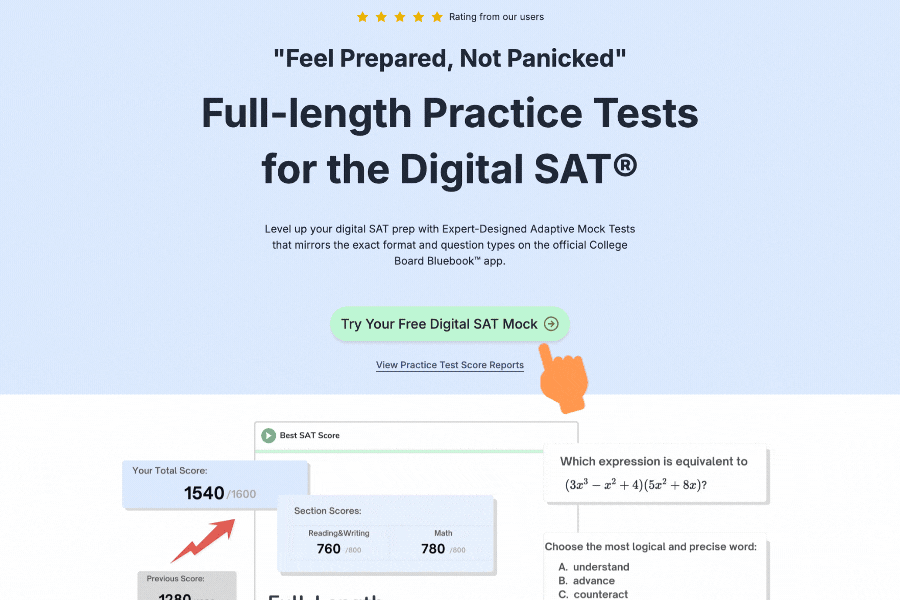Proven Tricks to Answer Faster and More Accurately
Practice these tricks to cut your answer time by 50% or more! 🚀
The Rhetorical Synthesis section doesn't have to be time-consuming. By recognizing question patterns and applying strategic elimination, you can often answer correctly before fully reading all the bullet points. Here's how:
Trick 1: Differences/Similarities Questions → Filter with Keywords
When the prompt asks about:
✔ Differences (e.g., "contrast," "differentce," "distinguish")
✔ Similarities (e.g., "common features," "similarity," "shared")
Strategies:
1️⃣ Must Mention Both (two) Subjects
- ✅ Correct: "While X does A, Y does B."
- 🚨 Eliminate Instantly: Any option discussing only one subject or introducing a new unrelated subject.
2️⃣ Transition Clues
(learn more on "Transitions" lesson page)
- If goal = similarities:
- ✅ Look for: "Similarly," "like," "also," "both," "too," "as well," etc.
- ❌ Eliminate: "However," "but," "unlike, (implies contrast)," "on the contrary," etc.
- If goal = differences:
- ✅ Look for: "unlike," "whereas," "while," "however," "but," etc.
- ❌ Eliminate: "Similarly," "in the same way," "both.. and..," "also," "too," etc.
Example (Similarity Goal):
- Prompt Goal: "To identify a shared trait between Renaissance and Baroque art."
- Wrong Option: "Renaissance art emphasized symmetry."
- 🚨 Eliminate: Only discusses one subject.
- Correct Option: "Both Renaissance and Baroque art used religious themes."
💡 Saves time by skipping options that structurally can't be right.
Trick 2: Specific Keyword Lock (Time/Place/Person)
When the goal targets:
✔ A specific detail (e.g., "to introduce which city...," "to explain when...," "to illustrate whose contribution..").
Strategies:
1️⃣ Scan Options for the Keyword
- The correct answer must include the prompt's key term (e.g., "..in New York..(a city name), "1920s(a specific time)," "Marie Curie(a person's name)").
- 🚨 Eliminate any option missing it.
2️⃣ Target Bullet Points
- Now, only read bullet points referencing that keyword to verify the answer.
Example:
- Prompt Goal: "To describe when technology began to undergo tremendous changes"
- Option A: "Computers became smaller over time."
- 🚨 Eliminate: No mention of a time word/phrase.
- Option B: "Since 1980s, personal computers entered households...."
- ✅ Check Notes: If the bullet points mention 1980s + PCs → Correct!
💡 Avoids wasting time on unrelated details.
Trick 3: Summaries/Introductions → Demand Breadth
When the goal asks to:
✔ Summarize or introduce (e.g., "Provide a summary," "Provide an overview," "Explain to someone unfamiliar..").
Strategies:
1️⃣ Eliminate Narrow Options
- Incorrect choices often focus on one minor point.
- ✅ Correct answers cover multiple bullet points.
2️⃣ Verify with Notes
- For remaining broad options, cross-check if they incorporate multiple ideas from the notes.
Example (Summary Goal):
- Bullet Points:
- Method A saves time.
- Method A reduces errors.
- Method B costs less than Method A.
- Wrong Option: "Method A is efficient."
- 🚨 Eliminate: Only covers one method.
- Correct Option: "Method A can improve efficiency and accuracy, but it costs more than Method B."
💡 Summaries must be inclusive, not selective.
Real SAT Hack: Many questions can be answered without deep reading if you:
✔ Match the goal's structure (e.g., two subjects for comparisons).
✔ Lock keywords (e.g., time/place/person).
✔ Reject narrow answers (for summaries).
💡 Pro Tip: On harder questions, use the eliminated wrong choices to reverse-engineer the right one. If three options fail Tricks 1-3, the last must be correct!
